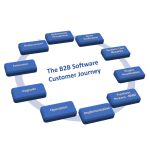Is Cold Calling Really Dead? – Part 3
In my recent post under the title “Is Cold Calling Really Dead?” I promised more examples of companies where cold calling plays a significant and successful role in growing revenue, market share and company value.
In part 2 I described a business case where cold calling was the critical approach to success.
Today’s case story is about how a start-up uses cold calling for business development purposes.
Meploy – the situation
 Meploy is an app and an Internet platform for connecting companies with blue-collar temp-workers.
Meploy is an app and an Internet platform for connecting companies with blue-collar temp-workers.
The challenge for companies using blue-collar temp-workers are:
- They have a hard time predicting where, when and how many workers they may need. Thus, they often require the people at very short notice.
- The jobs to be done are time critical (containers to be filled/emptied, goods to be plucked, packed and shipped, etc.). Thus, they need people they can trust will show up and do the job properly.
- The jobs to be done do not justify paying any major overhead costs on the direct salary.
The challenge for people looking for quick blue-collar temp-gigs are:
- There is no organized market for this type of labor exchange. It takes too much time and effort to find work.
- The current temp-agencies add a substantial markup making the labor too expensive to the employer and unattractive to the employee.
- There is no way to demonstrate your virtues to potential employers.
Meploy was founded to organize this market using principles from the Internet-based sharing economy.
Building a community of 4.500 people looking for temp-employment in the greater Copenhagen area was not the big challenge.
Getting companies to use the platform was.
No inbound traffic
Despite a beautiful and SEO-optimized website plus regular SoMe and PR activities, there were not enough incoming inquiries to get the business going.
Taha Aharaz, responsible for revenue generation at Meploy, decided to embark on an outbound approach systematically calling on companies that were believed to need blue-collar workers.
Exploring and testing
“We needed to check a series of questions before we could be confident that outbound cold calling would provide revenue at a reasonable level of customer acquisition cost,” says Taha Aharaz.
Such questions were:
- Do the industries, we have chosen, have a significant need for blue-collar temp-workers?
- Are we addressing the right job titles?
- What are the typical objections we will meet?
- How much time do we need to get a contact?
- Can we sell a trial over the phone?
- What kind of fulfillment material do we need to follow up on the call?
Pre-call research
Suspects were identified through an industry search on LinkedIn. Before making the call Taha and his people would use a total of 5-10 minutes on LinkedIn to determine the right contact person and then check the company’s website for a direct phone number.
Outcome
 After the first hundred calls, Meploy had answers to the six questions.
After the first hundred calls, Meploy had answers to the six questions.
- The industry focus was further narrowed.
- Line managers were the best starting point for a contact although internal company policies may place the hiring responsibility with someone else.
- There were many types of objections, but a change to the platform could address the most frequent and critical.
- The line managers were easy to get hold of over the phone.
- It was difficult to sell a trial over the phone, and the objective was shifted to booking a meeting.
- There is a need for a library of fulfillment options depending on the specific situation.
- There is a need for a nursing program that can take care of leads that are qualified but are not prepared to switch just now.
New customers are now added on a weekly basis, and current customers are extending their use of the platform. Revenue is growing month over month.
“Although we have growing revenue I consider our sales approach to still be in testing mode,” says Taha Aharaz. “In the foreseeable future, I see no immediate alternative to outbound cold calls. Waiting for prospects to find us, sign up for the service or calling us for additional information is not going to grow revenue fast enough for a service that is still considered a new alternative.”









